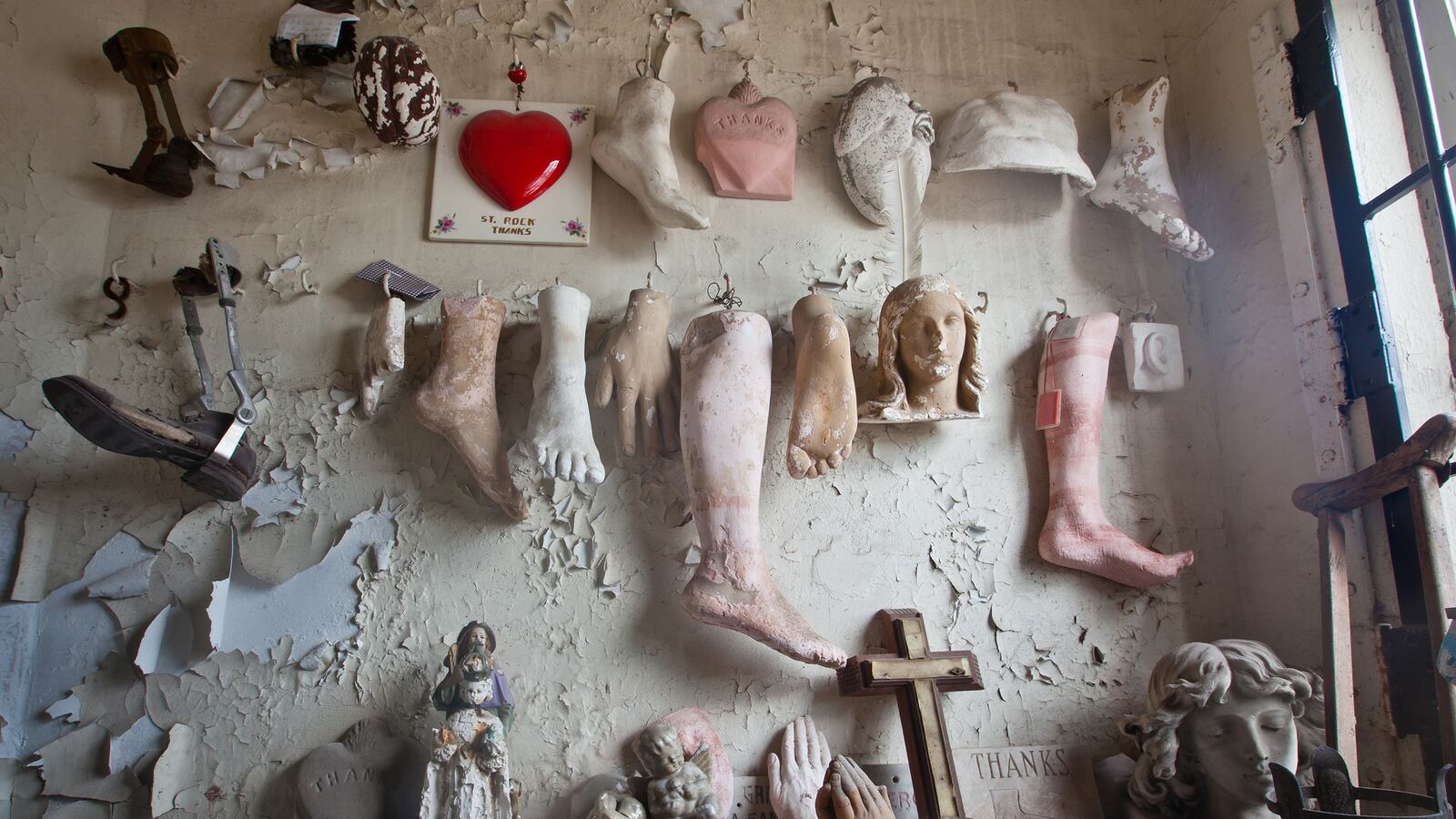Inside a historic New Orleans chapel, a bizarre room has become the final resting place for a variety of prostheses, crutches, and other symbols of maladies. For more than a century, devout visitors have been leaving these macabre tokens as prayers or out of gratitude for a cure to their ailments.
Locks of hair are nailed to the walls. A glass box holds what appear to be glass eyes. Leg braces with attached shoes hang from the wall. Plaster and ceramic replicas of organs and appendages rest on the shelves alongside sets of false teeth. A decaying statue of St. Lucia, patron saint of the blind, holds a platter with two eyes. On the floor, the bricks are inscribed with “Merci” and “Thanks” and covered in a layer of coins.
This room of relics within St. Roch’s Cemetery Chapel is filled with dusty ex-votos, offerings to saints for a miracle well done. There are whispers of a history of voodoo ceremonies and mysterious orbs of light appearing in photos. The rest of the chapel’s narrative, past and present, is equally eccentric.
The grounds of the gothic structure are set off from the street behind a gated cemetery and are unofficially kept by a man who calls himself Roch. Though he apparently has no formal affiliation with the church, he ensures the Renaissance chants are always booming in the air, lights candles, and arranges decorations in the chapel. He also keeps a watchful eye on the piles of offerings, though he told Narratively's Eve Troeh recently that he never removes anything. “The other day I found a box of some kind of dried Thai rice mixture,” he said. “Things come and go. That’s fine. I don’t think I’m guarding it. It just kind of lives on its own.”
The ex-votos are not all contained within the cluttered room. On the road through the cemetery tombs to the chapel, one famous monument depicts a young girl lying on her back—it was brought from Italy by a mother grateful for her daughter’s speedy recovery.
The chapel and cemetery were built by Father Peter Leonard Thevis, a young German priest who arrived in Louisiana to preside over the religious needs of a neighborhood of German immigrants. At the time, New Orleans was a breeding ground for yellow fever and cholera. One deadly outbreak in 1868 killed hundreds weekly.
Legend has it, Father Thevis proclaimed that if no one in his congregation succumbed to the epidemic that year, he would build a monument to St. Roch, a French saint from the Middle Ages who treated plague victims after being saved from the disease by a loyal dog.
That year, the parishioners were spared, and Father Thevis kept his word. He traveled to Europe to get inspiration for his endeavor, and ended up modeling St. Roch’s after Rome’s Campo Santo de Tedeschi, a religious complex for Germans located on the southern part of St. Peter’s Basilica. On August 16, 1876, the chapel and its graveyard, Campo Santo, opened. Soon, believers seeking cures began flocking to the chapel and praying to its guardian angel, St. Roch. In a small room off the chapel, they left offerings of gratitude for filled promises of recovery.
Decades later, after Father Thevis had been buried under the floor in front of the altar of the chapel, another tradition sprung up around St. Roch: young girls seeking husbands traveled to each of the city’s nine churches, praying and paying alms. For extra luck they’d walk with rocks in their shoes and make sure to end their pilgrimage at St. Roch.
As is common in New Orleans’ cemeteries, St. Roch’s burial options also include above-ground tombs and vaults along the complex walls. This has been a longstanding practice due to the city’s high water tables. In the cemetery fronting the chapel, the surrounding fortification offers temporary and economical burial vaults. Each inhabitant is granted a year-long lease before workers collect their remains or push them into a communal bones cellar to make way for a newly deceased occupant.
This off-the-beaten-path chapel even has holy anointment. In the middle of the grounds, a large sculptural depiction of Jesus on the cross was sent to the Vatican and consecrated by Pope John XXIII before being installed in the Campo Santo. Prominent New Orleans families have been buried here for generations, and will continue to be, just as the chapel’s shelves and walls will continue to be filled with macabre tokens of ailments past.






